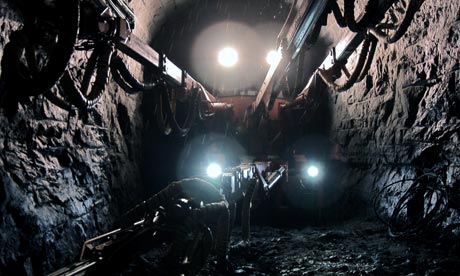This jaw-dropping documentary tackles a subject almost beyond comprehension, says Peter Bradshaw

Barely even conceivable … Onkalo in the film Into Eternity
In many ways, this unassuming, modestly proportioned documentary
from Finnish film-maker Michael Madsen (no relation to the Hollywood
bad guy) is one of the most extraordinary factual films to be shown this
year: my only quarrel is that it is perhaps too short, and could have
done with more wide-ranging interviews to tackle its implications.
Madsen's film is about Onkalo, a colossal underground tomb being built
in Finland, 500 metres below the earth – supposedly impervious to any
event on the surface and far away from any possible earthquake danger:
its purpose is to house thousands of tonnes of radioactive nuclear
waste. Onkalo is the first storage site of its kind, and Madsen
interviews the various technicians, scientists, legislators and
commentators involved in this awe-inspiring project.
The point is that, to be safe, this gigantic bunker has to last
100,000 years. Are we humans capable of even conceiving this, let alone
actually guaranteeing it? Our own history spans a few paltry millennia.
We have, of course, created nothing that has lasted anything like this
length of time. And yet Onkalo has to do it – there is no question about
this. Finland is building something that must outlast every institution
humans have ever conceived.
Madsen's film does not merely ask tough questions about the implications of nuclear energy – now enjoying a fashionable renaissance as the burning of fossil-fuels becomes increasingly unacceptable – but about how we, as a race, conceive our own future. My jaw descended at Madsen's interviews with the Finnish guardians of this place, and at what they had to consider. Should they put markers or warnings on the site warning away any future people who, tens of thousands of years from now, stumble upon it? Languages might be pointless. How about runic symbols or signs? Quite seriously, the site's designers were considering using Munch's The Scream as a way of getting the message across.
But Onkalo's designers had to consider the possibility that it might be safer to leave it unmarked. An array of symbols might simply whet the curiosity of any future visitors: they might become insanely excited at the thought of a Tutankhamun-style vault.
Onkalo might seem an unimaginably mysterious shrine to the gods. And is that, in fact, precisely what we are building here? My blood ran cold as one engineer involved in this project said that the project had to be "independent of human nature".
This is nothing less than post-human architecture we are talking about. Why isn't every government, every philosopher, every theologian, everywhere in the world discussing Onkalo and its implications? I don't know, but they should see this film.
- Into Eternity
- Production year: 2010
- Countries: Denmark, Finland, Italy, Rest of the world, Sweden
- Runtime: 75 mins
- Directors: Michael Madsen
Madsen's film does not merely ask tough questions about the implications of nuclear energy – now enjoying a fashionable renaissance as the burning of fossil-fuels becomes increasingly unacceptable – but about how we, as a race, conceive our own future. My jaw descended at Madsen's interviews with the Finnish guardians of this place, and at what they had to consider. Should they put markers or warnings on the site warning away any future people who, tens of thousands of years from now, stumble upon it? Languages might be pointless. How about runic symbols or signs? Quite seriously, the site's designers were considering using Munch's The Scream as a way of getting the message across.
But Onkalo's designers had to consider the possibility that it might be safer to leave it unmarked. An array of symbols might simply whet the curiosity of any future visitors: they might become insanely excited at the thought of a Tutankhamun-style vault.
Onkalo might seem an unimaginably mysterious shrine to the gods. And is that, in fact, precisely what we are building here? My blood ran cold as one engineer involved in this project said that the project had to be "independent of human nature".
This is nothing less than post-human architecture we are talking about. Why isn't every government, every philosopher, every theologian, everywhere in the world discussing Onkalo and its implications? I don't know, but they should see this film.

No comments:
Post a Comment